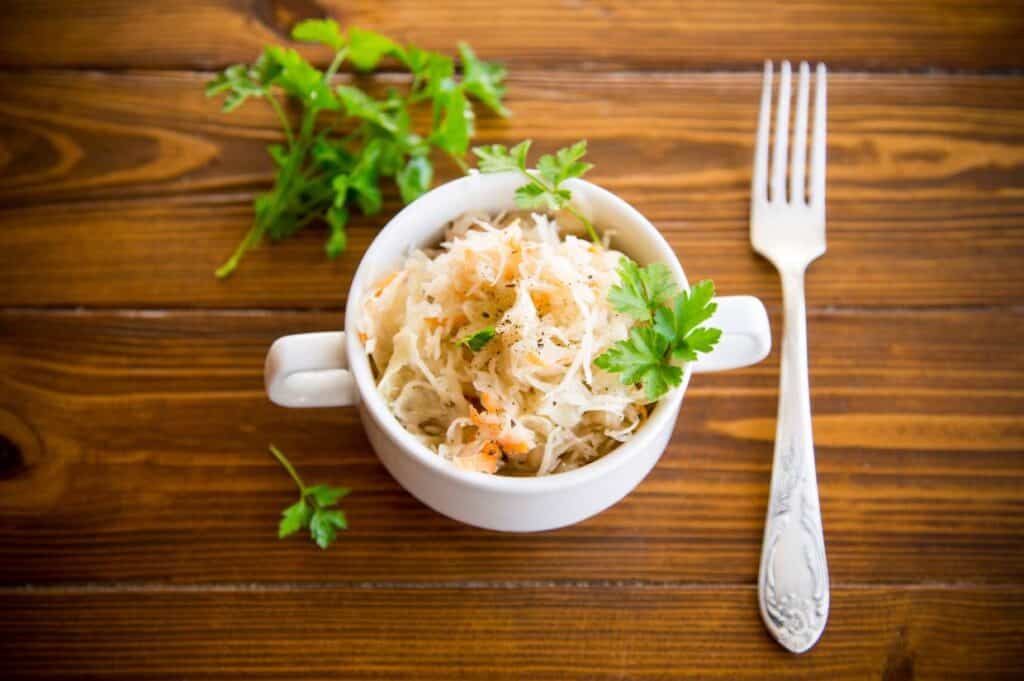Want a healthier gut? Eating natural probiotic foods might help. From yogurt to sauerkraut, these foods are as tasty as they are nutritious.

These statements have not been evaluated by the Food and Drug Administration. Please see the disclaimer below for more information.
Benefits of probiotic foods for better health
Natural probiotic foods are delicious and packed with organically occurring probiotics that may benefit your health. Supplementing with store-bought strains is very common, but you can also find probiotics in fermented food.
Did you know fermenting grains into sourdough bread makes it easier for your body to absorb essential vitamins and minerals? That’s what the 2021 study “Enhancing Micronutrients Bioavailability through Fermentation of Plant-Based Foods” published in Fermentation details.
Later, Cureus summarizes the available literature in “Role of Probiotics in Human Health.” This analysis asserts, “Infections of the digestive tract, irritable bowel, lactose intolerance, allergies, infections of the urogenital tract, cystic fibrosis and various cancers can all be prevented and treated with the use of probiotics.”
If you haven’t already, speak with your doctor regarding gut health and explore the options together. Avoid making dietary changes before consulting a specialist.
8 best natural probiotic foods you’ll love
There are plenty of probiotic options to buy or make at home if you’re looking for an easy way to level up your wellness routine. From fermented vegetables to yogurt and kefir, these foods are delicious and packed with beneficial bacteria.
“As a tradition from my childhood, we make homemade sauerkraut, curd cheese and pickles every single year for the whole winter. Since I got my Instant Pot, I have been making yogurt every week, which is tastier and cheaper than store-bought.”
— Zuzana Paar, Low Carb No Carb

Yogurt
Yogurt is a long-standing cultural food eaten worldwide. Making yogurt involves fermenting milk with live bacteria cultures, such as Lactobacillus bulgaricus and Streptococcus thermophilus. These bacteria convert the lactose in milk into lactic acid, which gives yogurt its characteristic tanginess and thick texture.
Choose from regular, Greek or Icelandic, among other varieties. There are also non-dairy options like soy or coconut milk yogurt, catering to those with dietary restrictions or preferences. Serve it plain or with fresh fruit and honey. You can also use it as a base for smoothies and salad dressings.
Sauerkraut
Sauerkraut is a traditional fermented cabbage dish that has a rich history and cultural significance across Europe. Make sauerkraut by mixing finely shredded cabbage with salt and leave it to ferment for a few days or up to several weeks. Homemade sauerkraut is easy enough, even for beginners. You can make variations with green, red or Chinese cabbage and by adding caraway seeds, juniper berries or apples for extra flavor.
Sauerkraut is commonly paired as a side dish or condiment with sausages, pork and sandwiches. It can also be used as an ingredient in various recipes, such as soups, stews and casseroles.
Kimchi is a similar but different fermented cabbage dish from Korea. It is spicy and contains radish, chili peppers, garlic and ginger.
FDL’S 75 Best Bites

Our cookbook with 75 tasty recipes will be your go-to kitchen companion for easy dinners with ad-free recipes right at your fingertips. Crafted by experienced chefs and recipe developers, this collection offers a treasure trove of tried-and-true dishes that make mealtime a breeze.
Get the Recipe: FDL’S 75 Best Bites
Kombucha
In recent years, kombucha has gained popularity due to its unique flavor profile and the increasing interest in probiotic foods. Originally from China, this beverage comes in flavors ranging from fruity to floral.
Some people drink kombucha chilled, straight from the bottle. Others like to serve it over ice and garnish with fresh fruit or herbs. You can also use kombucha as a base for cocktails and mocktails.
“After spending far too much money on store-bought ferments, I learned how to ferment my own vegetables at home. It’s so much easier than you’d think and extremely cost-effective.”
— Gina Matsoukas, Running to the Kitchen
Pickles
Pickles are a popular food made by pickling, which preserves vegetables and fruits in a solution of vinegar, water and spices. Did you know pickles are made using a variety of vegetables like carrots, cauliflower and onions, as well as fruits like lemons and mango? You can even make pickled eggs, but cucumbers are the most common.
Cucumber pickles are often served as a condiment on hamburgers, hot dogs and salads. They can be munched on their own as a snack or as an ingredient in recipes like pickle chips.
Buttermilk
Buttermilk is a tasty, natural probiotic food made from leftover liquid after churning butter. It is a tangy and creamy liquid suitable for baking, cooking and enjoying on its own. In India, spiced buttermilk, known as “chaas” is a popular refreshing drink flavored with spices like mint, ginger and green chili.

Cheese
Cheese is a popular food among Americans and one that naturally contains probiotics. Harvard Medical School identified the highest amount of probiotics in aged cheeses that are not heated or cooked. Examples include soft and hard cheese like Swiss, provolone, Gouda, cheddar, Edam and Gruyère. Serve cheese as a snack or appetizer with fruits, nuts or cured meats.
Kefir
Kefir is another natural probiotic food from dairy. It’s similar to yogurt but with a distinct texture and taste made by fermenting milk with kefir grains, which are little clusters of bacteria and yeast.
Kefir originated in the Caucasus Mountains and has been consumed for centuries by various cultures, including the people of Russia, Turkey and the Middle East. Drink it plain or flavored with fruits, honey or spices. You can also strain the whey and produce a soft kefir cheese for spreading on bread and crackers.
Miso
Miso is a traditional Japanese seasoning made from fermented soybeans with a specific culture called koji. This mixture is then fermented for at least six months to develop its distinct umami flavor and aroma.
There are several notable variations of miso, each with its flavor profile and uses. The most common types include:
- White miso or shiro miso with a milder and sweeter taste.
- Red miso has a more robust and saltier flavor.
- Mixed miso or “awase” miso is a combination of different types of miso.
Use miso in various dishes as a seasoning and as a base for soups and sauces. It also adds depth and complexity to dressings and glazes for roasted vegetables or fish.
In conclusion
Including natural probiotic foods in your meals is a simple way to support your gut and overall well-being. These foods are culturally significant and can be bought or made at home.
Always work closely with your trusted health practitioner to strategize and identify the right approach for you. There are many delicious options to enjoy alone or mixed with other ingredients.
Jessica Haggard is dedicated to helping people cook easy everyday recipes focusing on bioavailable and nutrient-dense foods. She helps people overcome food allergies and discover healthy recipes that make a difference in their health with gluten-free, low-carb and keto cooking at Primal Edge Health.
Disclaimer: These statements have not been evaluated by the Food and Drug Administration. The contents of this article, made available via Food Drink Life, are for informational purposes only and do not constitute medical advice. The Content presented here is not intended to be a substitute for professional medical advice, diagnosis, or treatment. Always seek the advice of a qualified healthcare provider with any questions you may have regarding a medical condition or dietary changes. Reliance on any information provided by this article is solely at your own risk.